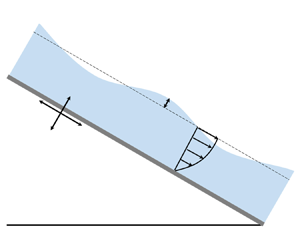Article contents
Instability of a weakly viscoelastic film flow on an oscillating inclined plane
Published online by Cambridge University Press: 23 May 2024
Abstract

The long- and finite-wavelength instabilities of weakly viscoelastic film on an oscillating inclined plane are investigated. By using the Chebyshev series solution with the Floquet theory, the combined effects of viscoelasticity and forcing amplitude on instability are described when the inclined plane oscillates in streamwise and wall-normal directions. For long-wavelength instability, the solution to the eigenvalue problem is obtained analytically by the asymptotic expansion method. Results show that the Floquet exponent is independent of the wall-normal oscillation amplitude. The effects of inclined angle, gravity and surface tension on the stability of viscoelastic liquid film are also discussed. For finite-wavelength instability, numerical results corresponding to the wall-normal oscillation disclose that with the increase of viscoelasticity, the unstable gravitational boundary moves to a higher wavenumber, and the critical amplitudes of subharmonic and harmonic instabilities are reduced. The neutral curve of gravity instability for streamwise oscillatory flow is divided into two parts, and a stable bandwidth is formed for a large value of the viscoelastic parameter. Besides, a new oscillatory mode is identified at small angles of inclination, which will be enhanced if the effect of viscoelasticity is incorporated.
JFM classification
Information
- Type
- JFM Papers
- Information
- Copyright
- © The Author(s), 2024. Published by Cambridge University Press
References
- 5
- Cited by


